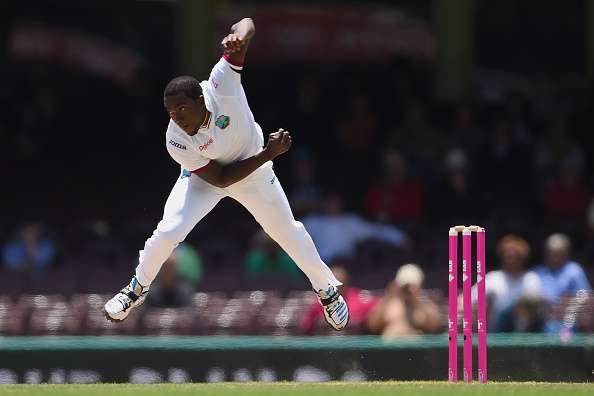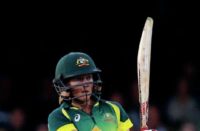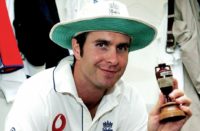Garfield Robinson looks back at a Test career that remained sadly unfulfilled due to injuries
At his best, West Indies fast bowler Jerome Taylor can be seriously devastating, capable of raining down sudden and complete destruction on the opposition’s batting. At his best he is a bowler of considerable skill and rapid pace, and it has been so from the time he was very young.
He was only around 10 when he approached his father one day, delivering himself most importunately, suggesting that he was now ready for a place on the local cricket team that the senior Taylor captained. Deciding to indulge his son, he brought him along to the next practice session and handed him the ball. The result: three wickets in his first three deliveries, all bowled. It would have been four in four, too, for the batsman was hit dead in front, but there was, of course, no umpire.
Taylor went on to star for his high school, St Elizabeth Technical, in Jamaica, and made his first-class debut in February 2003 against the Windward Islands at Sabina Park. Disappointingly wicket-less in his first game – clearly the victim of nerves – he was dropped for the next two, but returned for the encounter against Guyana at Bourda where he collected only one wicket, though he bowled well.
The next game was against Trinidad at the Queens Park Oval, and those fortunate enough to witness the Jamaican quick’s performance in the second innings spoke about it for a long time.
From 20.5 overs he snatched 8-59, seven of them bowled or leg before. Bowling at high pace, he was particularly proficient at bringing the ball startlingly back into the right-hander. Based on that performance many predicted a long and fruitful international career. Taylor first played for the West Indies in n ODI in St. Vincent, against Sri Lanka, and did well enough, taking 2-39 runs off 10 overs. He made his Test debut nine days later on June 20, 2003, in St. Lucia, against the same opposition. He was 18.
Injury, illness, and indifferent form and fitness, meant that his appearances for the West Indies were mostly sporadic, though he had a consistent run after returning from injury in 2014, and prior to him retiring from Tests in July 2016.
While he has bowled well on occasion, his performances have been, at best, patchy. There was a hat-trick against Australia in 50-over game and there were five-wicket hauls against India, Pakistan and Australia (there was also a run-a-ball century against New Zealand in Dunedin in 2008).
But the wily fast bowler who destroyed Trinidad and Tobago early in his first-class career has not often been in evidence, and only rarely has everything come together for the 6ft 1in Jamaican.
On one memorable day at Sabina Park, however, everything clicked. He ran in hard, bowled rapidly, and exhibited exemplary control of direction and movement.
It was February 7, 2009, and the first Test of the 2008/09 series against England had reached its fourth day. The West Indies had responded to the visitor’s first innings score of 318 with 392, the innings closing before lunch. And though nobody would have dared imagine it at the time, that rather measly lead was to prove insurmountable.
England would have been a bit worried at the break, because they were already 11-2, after Devon Smith accepted a catch at slip from a ball that Taylor slanted across Alastair Cook, while Ian Bell, middling everything beautifully, as is his wont, then carelessly went, caught behind off Sulieman Benn attempting to cut a wide delivery.
Still, there was no indication of the mayhem that was to unfold, and with so many high quality wickets still intact, England would have been confident of staging a recovery.
But then first ball back Kevin Pietersen, who had missed a first innings century by just three runs, had his off-stump uprooted by a peach of a ball from Taylor. Full and heading toward middle, it swung away wickedly late, evading Pietersen’s outside edge, sending the stick cartwheeling. It was a delivery that would almost certainly have defeated any right hander of any era.
The crowd erupted. This was a scene that recalled the days when the great four pronged pace attack ran rampant, sending batsmen ducking and stumps flying. The kind of scene those in attendance had not often seen since those heady days, and, whenever they had, it was more likely it would have been West Indian batsmen on the receiving end.
Andrew Strauss had laboured 69 minutes over nine runs when Taylor urged a good length delivery to slightly leave the left-hander and graze the edge of his defensive bat. Wicketkeeper Denesh Ramdin completed the dismissal.
There was more jubilation and dancing in the stands when the obdurate Paul Collingwood was undone by a delivery that snaked wickedly back into him to disturb his leg stump via his inside edge. Not realising his predicament, he hurried up and down the pitch, and it took his partner, Fred Flintoff, to let him know that as his bails had been dislodged, he was out had to return to the pavilion.
Matt Prior lasted just four deliveries. He was sent on his way courtesy of a well-camouflaged slower ball, effectively a fast off-break, that made its way between bat and pad to remove his off-stump. Failing to make contact with the delayed delivery at the point he expected, the batsman pushed out farther still, opening a gap through which the ball sneaked. Michael Holding, doing TV commentary at the time, was so impressed he went on and on about the dismissal. At that point the innings was in ruins at 23-6. Taylor, in the spell of his life, had taken 5-11 in 7.5 overs. It was fast bowling of the very highest class. He completed the over, bowled another, a maiden, before being given a rest. Fidel Edwards and Benn then wrapped up the innings for 51, and England were defeated by an innings.
A Cricinfo panel voted Taylor’s effort the best bowling performance in Tests for 2009. But that was to prove the high point of his career and nine months later a near five-year gap in his Test career followed.
Two years after that it was all over.
In the meantime, there was a gentleman seated in the George Headley stand who seemed somewhat sombre amid all the bedlam. Observed complaining under his breath he related the source of his troubles to a fellow spectator.
It turned out that, upon seeing the game tantalisingly poised at lunch, and expecting an exciting conclusion the next day, he purchased a number of fifth-day tickets for himself, members of his family and a few friends.
He was worried that he would not be getting his money back.
How West Indies cricket would have wished Taylor had got that sort of form back over the past few years.
This piece originally featured in The Cricket Paper, October 21 2016
Subscribe to the digital edition of The Cricket Paper here















